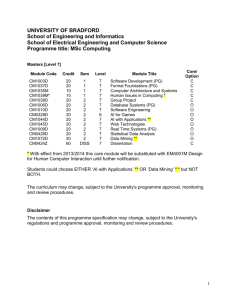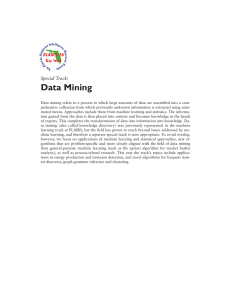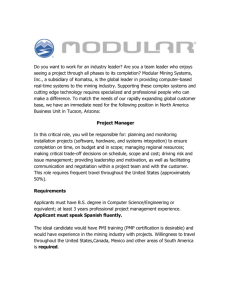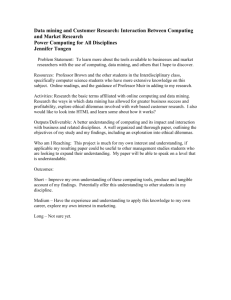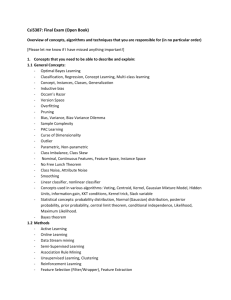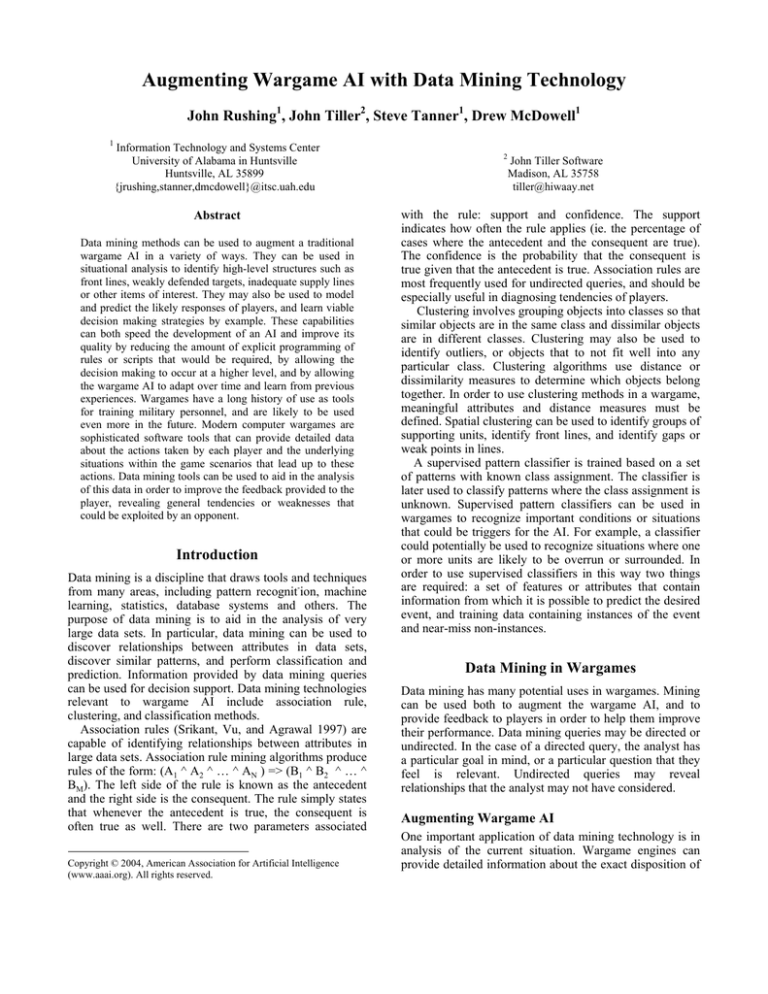
Augmenting Wargame AI with Data Mining Technology
John Rushing1, John Tiller2, Steve Tanner1, Drew McDowell1
1
Information Technology and Systems Center
University of Alabama in Huntsville
Huntsville, AL 35899
{jrushing,stanner,dmcdowell}@itsc.uah.edu
Abstract
Data mining methods can be used to augment a traditional
wargame AI in a variety of ways. They can be used in
situational analysis to identify high-level structures such as
front lines, weakly defended targets, inadequate supply lines
or other items of interest. They may also be used to model
and predict the likely responses of players, and learn viable
decision making strategies by example. These capabilities
can both speed the development of an AI and improve its
quality by reducing the amount of explicit programming of
rules or scripts that would be required, by allowing the
decision making to occur at a higher level, and by allowing
the wargame AI to adapt over time and learn from previous
experiences. Wargames have a long history of use as tools
for training military personnel, and are likely to be used
even more in the future. Modern computer wargames are
sophisticated software tools that can provide detailed data
about the actions taken by each player and the underlying
situations within the game scenarios that lead up to these
actions. Data mining tools can be used to aid in the analysis
of this data in order to improve the feedback provided to the
player, revealing general tendencies or weaknesses that
could be exploited by an opponent.
Introduction
Data mining is a discipline that draws tools and techniques
from many areas, including pattern recognit-ion, machine
learning, statistics, database systems and others. The
purpose of data mining is to aid in the analysis of very
large data sets. In particular, data mining can be used to
discover relationships between attributes in data sets,
discover similar patterns, and perform classification and
prediction. Information provided by data mining queries
can be used for decision support. Data mining technologies
relevant to wargame AI include association rule,
clustering, and classification methods.
Association rules (Srikant, Vu, and Agrawal 1997) are
capable of identifying relationships between attributes in
large data sets. Association rule mining algorithms produce
rules of the form: (A1 ^ A2 ^ … ^ AN ) => (B1 ^ B2 ^ … ^
BM). The left side of the rule is known as the antecedent
and the right side is the consequent. The rule simply states
that whenever the antecedent is true, the consequent is
often true as well. There are two parameters associated
Copyright © 2004, American Association for Artificial Intelligence
(www.aaai.org). All rights reserved.
2
John Tiller Software
Madison, AL 35758
tiller@hiwaay.net
with the rule: support and confidence. The support
indicates how often the rule applies (ie. the percentage of
cases where the antecedent and the consequent are true).
The confidence is the probability that the consequent is
true given that the antecedent is true. Association rules are
most frequently used for undirected queries, and should be
especially useful in diagnosing tendencies of players.
Clustering involves grouping objects into classes so that
similar objects are in the same class and dissimilar objects
are in different classes. Clustering may also be used to
identify outliers, or objects that to not fit well into any
particular class. Clustering algorithms use distance or
dissimilarity measures to determine which objects belong
together. In order to use clustering methods in a wargame,
meaningful attributes and distance measures must be
defined. Spatial clustering can be used to identify groups of
supporting units, identify front lines, and identify gaps or
weak points in lines.
A supervised pattern classifier is trained based on a set
of patterns with known class assignment. The classifier is
later used to classify patterns where the class assignment is
unknown. Supervised pattern classifiers can be used in
wargames to recognize important conditions or situations
that could be triggers for the AI. For example, a classifier
could potentially be used to recognize situations where one
or more units are likely to be overrun or surrounded. In
order to use supervised classifiers in this way two things
are required: a set of features or attributes that contain
information from which it is possible to predict the desired
event, and training data containing instances of the event
and near-miss non-instances.
Data Mining in Wargames
Data mining has many potential uses in wargames. Mining
can be used both to augment the wargame AI, and to
provide feedback to players in order to help them improve
their performance. Data mining queries may be directed or
undirected. In the case of a directed query, the analyst has
a particular goal in mind, or a particular question that they
feel is relevant. Undirected queries may reveal
relationships that the analyst may not have considered.
Augmenting Wargame AI
One important application of data mining technology is in
analysis of the current situation. Wargame engines can
provide detailed information about the exact disposition of
friendly and enemy units, their capabilities and other
important factors. However, this information is often at a
level of abstraction that is far below the level where the
decision is being made. Consider the AI for a strategic
level ground based wargame. At the highest level, the AI
must decide whether to attack, defend the current position,
or withdraw. There may be several factors that influence
this decision, such as the scenario objectives, overall
strength of friendly and enemy forces, access to supplies,
available air support, weather and so forth. While some
factors like overall strength may be computed in a
straightforward way, other less obvious factors may benefit
from data mining analysis. Mining methods can be used to
recognize situations of interest such as units in danger of
being isolated, gaps in an enemy line, opportune targets for
air strikes etc.
Another important use of data mining technology is
learning strategies by example. Trainable pattern classifiers
can be used to model a decision making process based on
large numbers of sample decisions. The classifiers could
then be used both to predict the likely course of action of
opponents, and directly as components of an AI system.
Learning from examples is a challenging process, and there
are several factors that influence success. It is important to
provide the classifier information at the appropriate level
of abstraction. The data provided should contain enough
detail to make a decision, while irrelevant details should be
eliminated. The process of choosing the influencing
variables can be automated to some extent, either by using
classifiers with built-in selections mechanisms (such as
decision trees), or by using external feature selection
algorithms.
Perhaps the most difficult part of the learning process is
generating good examples. The examples must cover as
many cases as possible to ensure proper generalization of
the classifier. The number of games required to produce a
good number of samples will depend at least partly on the
level of abstraction of the decision. During the course of a
single game, a player may make a small number of
decisions dealing with overall strategy, and a much larger
number of decisions about the actions of individual units or
small groups of units. Another important consideration is
that the negative instances may far outnumber the positive
ones: for every action a player chooses there are vast
numbers of alternatives. In cases where the number of
examples available is restricted, a hybrid approach could
be used. An initial model could be constructed based on
expert knowledge, and then the model could be refined
based on experience.
Supervised pattern classification has been widely
studied, and there are a large number of classification
algorithms that are appropriate for use in wargames.
Supervised learning algorithms that incrementally learn
and can tolerate concept drift (functions or behaviors that
change over time (Widmer and Kubat 1996)) are especially
valuable in a wargame environment. Versions of
supervised learning algorithms exist with both of these
capabilities for neural networks (Polikar et. al. 2001),
support vector machines (Syed, Liu, and Sung 1999),
decision trees (Hulten, Spencer, and Domingos 1997), and
ensemble classifiers (Street and Kim 2001). In many cases,
producing a user-readable model is also of value. Decision
trees and belief networks (Heckerman 1995) are logical
choices in those instances. A classifier that is capable of
dealing with uncertainty is also valuable. Uncertainty may
occur on the input due to fog of war, or on the output if
more than one decision is appropriate, or if the case being
considered is outside the predictive range of the classifier.
Providing Player Feedback
Data mining tools can be used to help characterize, model,
and predict the behavior of human players. The
information provided by these tools can then be analyzed
for weaknesses or tendencies, and used to provide
feedback to the player. It can also be used to help devise or
refine AI strategies to challenge the player in future games
or scenarios. In general, data mining queries can be
partitioned into two classes: directed and undirected. In the
case of a directed query, the analyst has a particular goal in
mind, or a particular question that they feel is relevant. An
undirected query on the other hand may be used to identify
relationships or patterns that may be of interest for further
consideration. Undirected queries may reveal relationships
that the analyst may not have considered.
The attributes available for predicting the player
behavior depend on the level of information captured in the
game replay logs, and the amount of information available
to the player. Depending on how fog of war settings are
chosen and implemented, the player may not have exact
knowledge of the situation. For example, the player might
know that there are incoming aircraft at a given range, but
might not be able to distinguish ground attack aircraft (like
an A-10) from air superiority fighters (like an F-15)
without visual identification.
In order to make the preceding discussion more
concrete, it is useful to consider the concepts of directed
queries in the context of an actual wargame. Modern Air
Power is a game that has potential for use in training for
the United States Air Force. In this game, players control
aircraft, radars, SAM sites and other resources in an entire
theatre of operations. Players must make decisions about
when, where, and how to deploy the resources available to
them. The players’ decision making processes could be
captured by constructing classifiers that model key aspects
of their behavior. For example, classifiers could be
constructed to determine when a player willingly engages
in dogfights, how the player uses SAM sites, how they
deploy tanker aircraft and so forth.
Another alternative is to frame the data mining queries
in extremely general terms, with no specific targets in
mind. This is the approach that is often used in association
rule mining, where one is interested discovering
relationships between attributes. In the case of wargames,
the attributes may be user actions, events, game states, or
other features computed from the game logs. The mining
could be directed to discover patterns present at a
particular time, or to discover temporal patterns (Agrawal
and Srikant 1995) or sequences of events. This process is
complicated somewhat by the fact that the player’s
decisions may be at least partially governed by factors that
are not captured by the attributes. Furthermore, the
decisions may not be entirely consistent, as the player may
make different decisions in similar situations.
Demonstration
There are many interesting problems in ground-based
wargames related to identification of front lines. The AI for
a wargame should be able to determine where the fronts
are, which units constitute the front, and the locations of
any gaps or weak points in the front. There are many
possible ways to address these problems, including the use
of general-purpose segmentation and clustering algorithms.
The use of one such technique, Density Based Spatial
Clustering of Applications with Noise (DBSCAN) (Ester
et. al. 1996), is demonstrated.
Figure 1: Lines Broken by Terrain
(a) DBSCAN run with low
thresholds
(b) DBSCAN run with
high thresholds
DBSCAN is a density based clustering algorithm. It
identifies groups of samples or patterns that are connected
by contiguous dense regions in the pattern space. Unlike
many commonly used clustering techniques, it can form
clusters of arbitrary shape and size. The algorithm scales
very well as it only requires a single pass through the input
data set. DBSCAN can identify outliers, or patterns that do
not fit well in any particular cluster. DBSCAN is typically
used in clustering applications with sets of continuous
(real-valued) variables. These variables constitute an N
dimensional space where each dimension or axis
corresponds to a variable. The variables are often
normalized to have the same range so that they are given
equal weights by the distance function.
DBSCAN can be used to identify fronts in ground-based
wargames by identifying continuous groups of units that
are close enough together to provide mutual support.
Friendly units that constitute a continuous front line will be
grouped into a single cluster, while isolated units will be
identified as outliers. Gaps in the front will be exposed, as
Figure 2: Simulated Parachute Drop
(a) Before drop, light gray
line complete
(b) After drop, light gray
line split
the units on either side of the gap will be in different
clusters. The DBSCAN algorithm assumes that there is a
meaningful distance measure that is defined for the input
patterns. In the case of an N-dimensional pattern space,
distance measures such as Manhattan distance and
Euclidean distance are commonly used. For ground-based
wargames, it makes sense to consider the movement cost
of the shortest viable path from unit to unit. This path must
take into account variable movement costs for different
types of terrain, impassable hexes, features such as roads,
rivers and railroads, and the presence of enemy units. It
may be desirable to vary the radius by unit type, as some
units are much more mobile than others.
Another important consideration is the strength of the
units. A group of very weak units may not constitute a
viable front, even if there are large numbers of them. The
total strength of the units in a particular region is therefore
more interesting than the number of units. Assignment of a
strength rating will depend on the game engine and rules of
the game, and may consider factors such as the size of the
unit, its supply state, its morale level, any attrition it has
suffered and other factors. The maximum distance and
minimum strength acceptable are conveyed to DBSCAN
through tunable parameters (epsilon for distance,
minStrength for unit strength).
In order to demonstrate the algorithm, some simple
cases were devised. In each of the figures in this section,
there are two opposing sides, light gray and dark gray.
There are infantry units with strength of 5 and cavalry units
with strength of 2, represented by the standard symbols.
There are four types of terrain: clear, rough, mountain, and
ocean. The clear hexes are white, rough hexes light gray,
mountain hexes darker gray and ocean hexes darkest gray.
The clear hexes have a movement cost of 1, rough hexes 2,
and the mountains and ocean are assumed to be impassible.
The units forming the line are linked by solid lines
plotted from center to center of the connected units. A
cluster consists of all connected units. Figure 1 shows the
light and dark lines split by a mountain range. In addition,
there is a weak point in the southern part of the dark line.
When DBSCAN is run with liberal parameters (epsilon =
2, minStrength = 6), the southern part of the red line
appears unbroken. When DBSCAN is run with more strict
parameters (epsilon = 4, minStrength = 7), a gap in the line
appears, and one of the cavalry units is shown to be
isolated. Figure 2 shows long lines through rough terrain,
and illustrates the result of a hypothetical parachute drop
by dark. Figure 2a shows the situation before the drop, and
Figure 2b shows the situation afterwards. The result is a
break in the light line, and two isolated light units to the
north of the pass.
Conclusions
Wargames can benefit from the use of data mining
technologies, both in augmenting the wargame AI and in
providing feedback to players. Mining methods can aid in
situational analysis, decision making, adversarial response
prediction, and modeling. A wide variety of techniques
including clustering, classification and association rule
mining are applicable. A simple application of density
based clustering, namely the identification of front lines
and isolated units in a ground based wargame, was
illustrated.
Acknowledgements
Phase I and Phase II STTR funding from the Air Force
Office of Scientific Research, Dr. Robert Barker program
manager, is gratefully acknowledged.
References
Agrawal R. and Srikant, R. 1995. Mining Sequential
Patterns, In Proc. 11th Intl. Conf. on Data Engineering,
3-14.
Ester, M., Kriegel, H-P., Sander, J. and Xu, X. 1996. A
Density-Based Algorithm for Discovering Clusters in
Large Spatial Databases with Noise, In Proc. 2nd
International Conf. on Knowledge Discovery and Data
Mining (KDD-96), 48-66.
Heckerman, D. 1995. A Tutorial on Learning with
Bayesian Networks. Technical Report. MSR-TR-95-06.
Microsoft Corporation.
Hulten, G., Spencer, L., and Domingos, P. 1997. Mining
Time-Changing Data Streams. In Proc. Seventh ACM
SIGKDD International Conference on Knowledge
Discovery and Data Mining, 97-106.
Polikar, R. Upda, L., Upda, S.S. and Honavar, V. 2001.
Learn++: An Incremental Learning Algorithm for
Supervised Neural Networks. IEEE Transactions on
Systems, Man and Cybernetics, Part C, 31(4): 497-508.
Srikant, R., Vu, Q., and Agrawal, R. 1997. Mining
Association Rules with Item Constraints. In Proc. 3rd
Intl. Conf. On Knowledge Discovery and Data Mining,
67-73.
Street, W.N., and Kim, Y.S. 2001. A Streaming Ensemble
Algorithm (SEA) for Large-Scale Classification. In Proc.
Seventh ACM SIGKDD International Conference on
Knowledge Discovery and Data Mining, 377-382.
Syed, N.A., Liu, H. and Sung, K.K 1999. Handling
Concept Drifts in Incremental Learning with Support
Vector Machines. In Proc. Fifth ACM SIGKDD
International Conference on Knowledge Discovery and
Data Mining, 317-321.
Widmer, G. and Kubat, M. 1996. Learning in the Presence
of Concept Drift. Machine Learning 23: 69-101.

